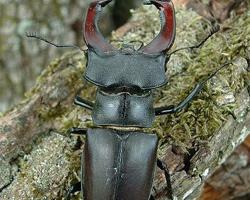
Statut de conservation
| Menacé |
Description de l'animal
The European stag beetle, scientifically known as Lucanus cervus, is one of the most impressive and iconic beetles found across Europe. This remarkable species is easily recognizable by its size, color, and the distinctive, oversized mandibles found on the males, which resemble the antlers of a stag, hence its common name. These beetles are part of the family Lucanidae, which encompasses a wide variety of beetles known for their formidable mandibles.Adult European stag beetles can reach lengths of up to 75 millimeters for males, while females are generally smaller, measuring up to 50 millimeters. The males' mandibles can be as long as their body length, which they primarily use for wrestling with other males during mating season to win over females. Despite their fearsome appearance, these mandibles are not used for biting. Instead, the beetles rely on their smaller mouthparts to feed. Females, on the other hand, have much smaller, more functional mandibles suited to their lifestyle, primarily focusing on reproduction and feeding.
The coloration of the European stag beetle is another distinctive feature, with adults sporting a shiny black head and thorax, while their elytra (wing cases) can vary from a reddish-brown to a dark, chestnut color. This vibrant contrast adds to their striking appearance, making them a fascinating find for nature enthusiasts.
The lifecycle of the European stag beetle begins with the female laying her eggs in rotting wood or tree stumps, which provides a nutrient-rich environment for the larvae. The larval stage is the longest phase in the beetle's life, lasting several years. During this time, the larvae feed on the decaying wood, growing larger until they are ready to pupate. This process can take anywhere from three to seven years, depending on environmental conditions. Once fully grown, the larvae pupate, transforming into the adult beetles, which then emerge from the wood to mate and continue the cycle.
Adult European stag beetles are most active during the warm summer months, particularly at dusk. They are often found in wooded areas, parks, and gardens, where they search for mates and suitable sites for the females to lay their eggs. While the adults can be seen flying clumsily in search of partners, they spend most of their short adult life, which lasts only a few weeks, focused on reproduction.
Despite their fascinating nature, European stag beetles are facing threats from habitat loss, pollution, and climate change. Their reliance on old trees and dead wood for their reproductive cycle makes them vulnerable to forestry practices and urban development, which reduces their natural habitat. Conservation efforts are underway in several countries to protect this species, including habitat management and public awareness campaigns to foster appreciation and protection of these remarkable beetiles.
In conclusion, the European stag beetle is a captivating species with its distinctive appearance, intriguing lifecycle, and the role it plays in forest ecosystems. As a symbol of the wild beauty of European woodlands, it serves as a reminder of the importance of conserving natural habitats for future generations to enjoy and marvel at.
Nouvelles photos d'animaux
Top 10 des animaux
- Dolphin gull (Leucophaeus scoresbii)
- Diana monkey (Cercopithecus diana)
- Moustached guenon (Cercopithecus cephus)
- Galápagos tortoise (Geochelone nigra complex)
- Russian tortoise (Testudo horsfieldii)
- Japanese macaque (Macaca fuscata)
- Stone loach (Barbatula barbatula)
- Greek tortoise (Testudo graeca)
- Common flying dragon (Draco volans)
- Colossal squid (Mesonychoteuthis hamiltoni)